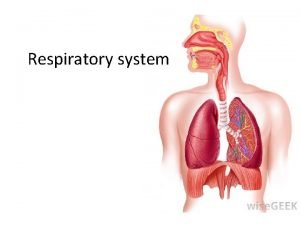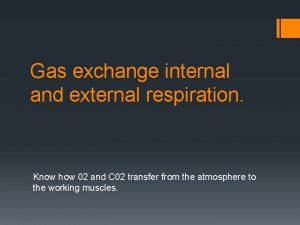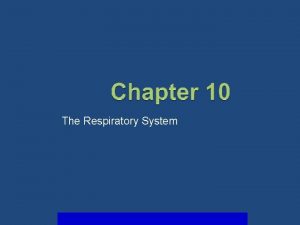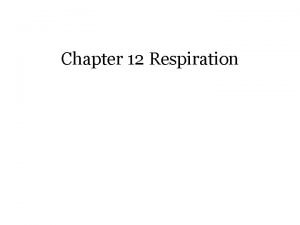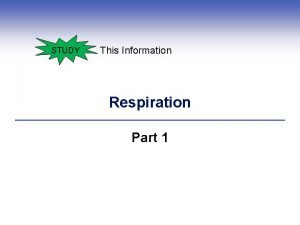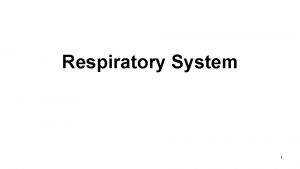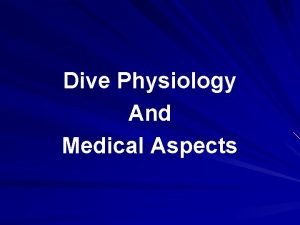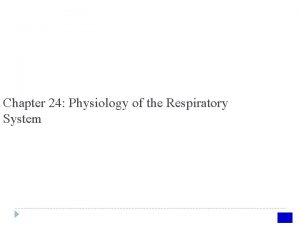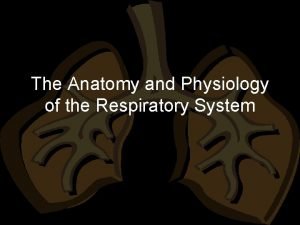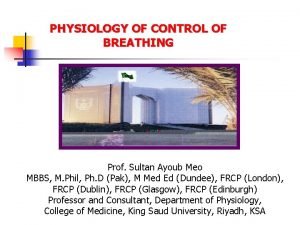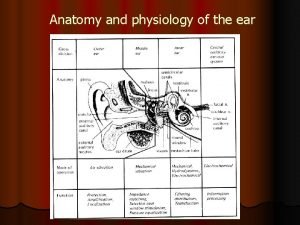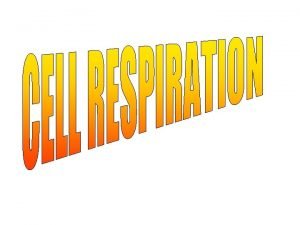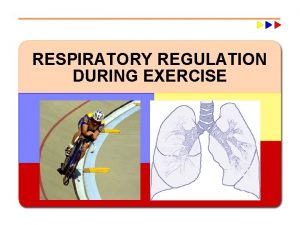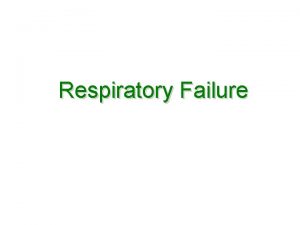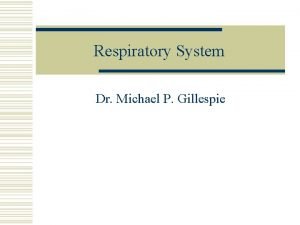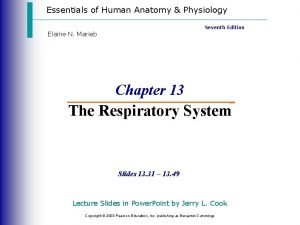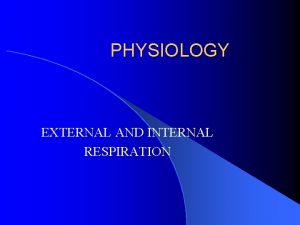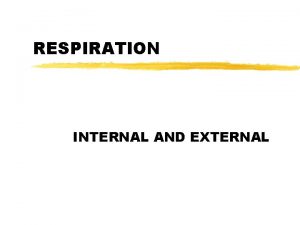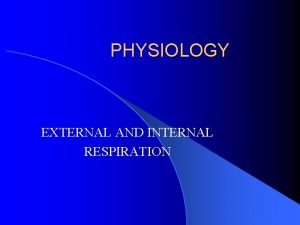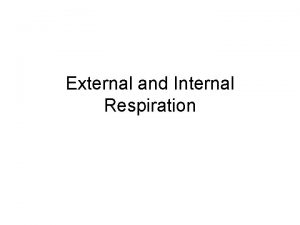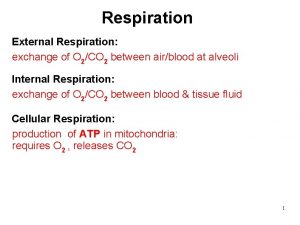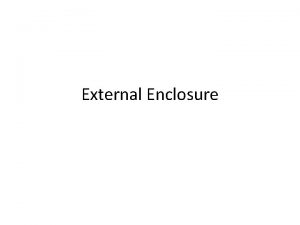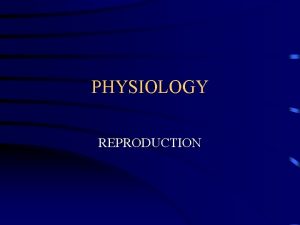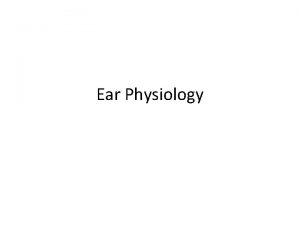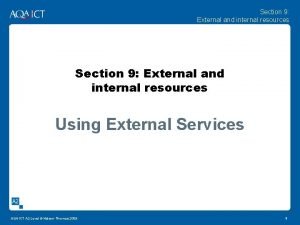Respiration Physiology External Respiration vs Internal Respiration exchange























- Slides: 23

Respiration Physiology

External Respiration vs. Internal Respiration �exchange of O 2/CO 2 btwn. fluids & environment (organ level) vs. btwn cells (cellular level)

Four major Steps of Respiration 1. Pulmonary Ventilation (breathing) air into & out of lungs 2. Gas Diffusion Across Respiratory Membrane from alveolar to alveolar capillaries 3. Storage and Transport of O 2/ CO 2 from alveolar caps to caps in tissues 4. Exchange of O 2/ CO 2 btwn blood and tissues

�The last two will be referred to as Gas pickup & delivery. �If any of these steps is affected hypoxia occurs ( tissues are starved of O 2) �If O 2 is completely shut off anoxia

Hypoxia

Boyle’s Law-

Pulmonary Ventilation air into and out of aveoli (continual supply of O 2 prevents build up of CO 2) �Boyle’s Law inverse relationship btwn volume & pressure of a gas. As one increases, the other decreases. �Inhalation/expiration changes the size of the lungs which changes the pressure

�Pressure gradients move air into & out from hi to low �Pleural cavity / fluid slide easily side to side but creates a suction when you try to separate Ex. wet glass on table �Surface of each lung sticks to wall of chest and top of diaphragm

�This fluid bond is actually what keeps lungs inflated! �Vol. of thoracic cavity changes when diaphragm or ribs move �When diaphragm is relaxed, it curves upward in a dome shape, when it contracts, it moves downward and increases the volume of cavity. Pg. 453 Fig. 16. 2

�Inhalation = ribs elevate, diaphragm contracts, size of cage increases, pressure decreases & air goes into the lungs. �The opposite occurs upon Exhalation = rib cage gets smaller, volume decrease, pressure increases, & air moves out of lungs.

Respiratory Cycle = 1 single inhalation & exhalation �Tidal volume = amt. of air into & out of lungs in a single respiration; avg. 500 ml --- but only 350 ml. enters aveoli; the other 150 ml. keep alveoli inflated. �Collapsed lung = when pleural fluid bond is broken

�Respiratory Muscles internal and external intercostals ( ribs) 25% of work diaphragm 75 % of work

�Mouth to mouth after each breath, contact is broken to permit passive exhalation, meets temporary O 2 demands of cells. �CPR cardiopulmonary resusitation �Pregnant women rely on costal breathing b/c diaphragm can’t move a lot

�Respiration rate = # of breaths per minute; avg. adult = 12 -18 � Air in alveoli always contains less O 2 and more CO 2 than outside air. This ensures that O 2 is constantly flowing INTO the aveoli.

Respiratory volumes �Resting tidal volume = amt. of air into/out of lungs during a quiet resp. cycle �Expiratory Reserve Vol. = amt. of air that COULD BE voluntarily expelled; 1000 ml! �Residual vol. = amt. left after maximum exhalation

�Inspiratory Reserve Vol. = amt. that can be taken in over & above the tidal vol. �Total Lung capacity = ( ER + TV + IR) + RV; 6 L in males; 4. 2 L in females �Spirometer = used to measure lung volumes �Wheezing = air whistling thru.

Henry’s Law

Gas exchange @ Resp. Membrane � � � Henry’s Law = gas molecules go from liquid into air easily ex. open can of soda Decompression sickness = decrease in pressure causes N 2 to come out of soln. & collect in joints; ex scuba divers Diffusion is efficient b/c -Difference in partial pressures is great - the greater the gradient, the faster the diffusion - if the pressure of O 2 decreases, that the diffusion into the blood decreases which makes people light headed @ altitudes of 3000 m or more. Fig. 16. 21 pg. 462 As blood goes from heart to lungs, there is more CO 2 than O 2; picks up O 2 and drops off CO 2 Goes to heart to get pumped systemically Goes to cells where O 2 is low and CO 2 is high; both are exchanged

BOHR Shift �O 2 transport �Hb saturation 1 heme can hold 4 O 2 �normally, heme is 50% saturated; only holds 2

Gas Pickup and Delivery �CO poisioning CO competes with O 2 for binding sites; CO usually wins b/c it has a higher affinity (liking) for Hb * treatments = breathe pure O 2 or transfuse RBC’s

Hb/p. H THE BOHR SHIFT pg. 463 �when p. H drops to 7. 2, Hb molecules change shape and release O 2 (lose affinity) � CO 2 combines with the water in the blood to make carbonic acid �H+ ionizes and lowers the p. H

�Hb and temp. as temp. increases, Hb releases more O 2, and vice versa; �ensures that skeletal muscles generating heat get the O 2 they need

�Fetal Hb has a much higher affinity for O 2 than adult Hb; ensures that fetus gets O 2 across placenta �CO 2 transport opposite reaction of BOHR SHIFT occurs; as p. H increases, heme gains affinity for O 2
 External vs internal respiration
External vs internal respiration External and internal respiration
External and internal respiration External vs internal respiration
External vs internal respiration External vs internal respiration
External vs internal respiration Differentiate between external and internal respiration
Differentiate between external and internal respiration Labled
Labled Bird respiratory system
Bird respiratory system Meduula
Meduula Amloplast
Amloplast Dive physiology
Dive physiology Pulmonary gas exchange and transport diagram
Pulmonary gas exchange and transport diagram Structure of the upper respiratory system
Structure of the upper respiratory system Primary secondary and tertiary bronchi
Primary secondary and tertiary bronchi Dr george ayoub
Dr george ayoub Physiology of external ear
Physiology of external ear Real exchange rate vs nominal exchange rate
Real exchange rate vs nominal exchange rate Voluntary exchange activity the pearl exchange
Voluntary exchange activity the pearl exchange Gas exchange key events in gas exchange
Gas exchange key events in gas exchange Meaning of cellular respiration
Meaning of cellular respiration External respiration
External respiration External respiration
External respiration Mechanism of breathing
Mechanism of breathing Function of pharynx
Function of pharynx External respiration
External respiration


